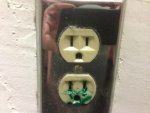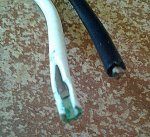A friend asked about green goo oozing from a duplex receptacle in his house. I located the following information:
Green gunge is most prevalent in cables made between 1965 and 1971. The
gunge is degraded di-isoctyl phthalate and is the result of the reaction
between the plasticisor in the insulation and the copper. Between 1965 and
1971 the temprature performance of PVC was uprated by the inclusion of an
anti-oxidant in to the PVC. An unappreciated side effect was that the
anti-oxident encouraged the production of exudate.
Evidence suggests that that high ambient temperatures accelarate the
process. The exudate is of low flammability and low toxicity. Although
unsightly it does not reduce the electrical integity of the conductor or the
insulation.
See also the draft BCA statement (April 2001) below: -
1) PVC
PVC comes in two main grades, plasticised and unplasticised PVC.
Unplasticised PVC (UPVC) is used for example in double glazing window frames
where a rigid material is required.
The PVC used for manufacture of cables is a plasticised PVC that conforms to
the relevant British Standard for the cable type in question.
2) Ageing effects
As a cable ages; (at temperatures above normal ambient), the elongation to
break decreases (also the Insulation Resistance increases). The life
expectancy of a cable is arbitrarily considered to be when the elongation to
break of the PVC is 50%.
A lower elongation to break value could be considered suitable especially
for a fixed wiring cable. Therefore, providing the cable is not subject to
movement or when moved due to inspection of socket outlet or the like, the
PVC does not crack, a much lower value of elongation to break is considered
by some as suitable.
3) Greening
Greening is the appearance of a wet green substance that is a product of an
adverse reaction between certain types of plasticiser and the copper
conductors. This greening, which is a rare occurrence, can happen either
after a long period of time for some cables, or if the cable has been
severely overheated.
The plasticiser itself is a clear oily liquid that is non conductive. The
green substance is a combination of copper oxide and plasticiser which may
become conductive under certain adverse conditions.
4) Action if Greening is found
Therefore whenever this green substance is found at socket outlets etc.
initially it should be removed and the terminations cleaned (gloves should
be used) otherwise it is possible that tracking/overheating may occur. It is
strongly recommended that rewiring should be carried out as soon as
possible.
If further information is required, the original cable manufacturer should
be contacted.
The info is from:
http://www.theiet.org/forums/forum/...ORUMVIEWTMP=Threaded&catid=205&threadid=10468
Your thoughts.
Green gunge is most prevalent in cables made between 1965 and 1971. The
gunge is degraded di-isoctyl phthalate and is the result of the reaction
between the plasticisor in the insulation and the copper. Between 1965 and
1971 the temprature performance of PVC was uprated by the inclusion of an
anti-oxidant in to the PVC. An unappreciated side effect was that the
anti-oxident encouraged the production of exudate.
Evidence suggests that that high ambient temperatures accelarate the
process. The exudate is of low flammability and low toxicity. Although
unsightly it does not reduce the electrical integity of the conductor or the
insulation.
See also the draft BCA statement (April 2001) below: -
1) PVC
PVC comes in two main grades, plasticised and unplasticised PVC.
Unplasticised PVC (UPVC) is used for example in double glazing window frames
where a rigid material is required.
The PVC used for manufacture of cables is a plasticised PVC that conforms to
the relevant British Standard for the cable type in question.
2) Ageing effects
As a cable ages; (at temperatures above normal ambient), the elongation to
break decreases (also the Insulation Resistance increases). The life
expectancy of a cable is arbitrarily considered to be when the elongation to
break of the PVC is 50%.
A lower elongation to break value could be considered suitable especially
for a fixed wiring cable. Therefore, providing the cable is not subject to
movement or when moved due to inspection of socket outlet or the like, the
PVC does not crack, a much lower value of elongation to break is considered
by some as suitable.
3) Greening
Greening is the appearance of a wet green substance that is a product of an
adverse reaction between certain types of plasticiser and the copper
conductors. This greening, which is a rare occurrence, can happen either
after a long period of time for some cables, or if the cable has been
severely overheated.
The plasticiser itself is a clear oily liquid that is non conductive. The
green substance is a combination of copper oxide and plasticiser which may
become conductive under certain adverse conditions.
4) Action if Greening is found
Therefore whenever this green substance is found at socket outlets etc.
initially it should be removed and the terminations cleaned (gloves should
be used) otherwise it is possible that tracking/overheating may occur. It is
strongly recommended that rewiring should be carried out as soon as
possible.
If further information is required, the original cable manufacturer should
be contacted.
The info is from:
http://www.theiet.org/forums/forum/...ORUMVIEWTMP=Threaded&catid=205&threadid=10468
Your thoughts.



